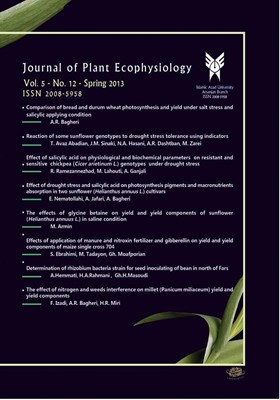The effect of nitrogen and weeds interference on millet (Panicum miliaceum) yield and yield components
Subject Areas : Journal of Plant EcophysiologyF. Izadi 1 , A.R. Bagheri 2 , H.R. Miri 3
1 - دانشجوی کارشناسی ارشد دانشگاه آزاد اسلامی واحد ارسنجان
2 - استادیار دانشگاه آزاد اسلامی واحد اقلید
3 - استادیار دانشگاه آزاد اسلامی واحد ارسنجان
Keywords:
Abstract :
In order to consider the effects of nitrogen and weeds interference (Amaranthus retroflexus L and Chenopodium album) on millet yield and yield components, an experiment has been done in a greenhouse in Bavanat region, Fars province, in atumn 2010. The experimental design was completely randomized with a factorial treatment arrangements replicated three times. The first factor, was the rate of nitrogen from urea source including; 0, 100, 200 kg nitrogen per ha and the second factor was the competition of millet and weeds in 3 levels included a pure millet without weeds and 2 levels of millet and weeds intercropping (Pigweed and Lamsquarter). Measured traits were grain yield, biological yield, harvest index and plant relative yield (PRY). The results showed that the effects of weeds interference on millet yield and yield components were significant. The increase of nitrogen level from 100 kg/ ha to 200 kg was not noticeably affect millet yield because of the high weeds competition; the increase of nitrogen resulted the decrease in milled yield. The effect of various nitrogen levels and various weed treatments and their effects on grain yield, biological yield and the harvest index of millet were significant. The PRY index decreases with the increase of weed density. In the mixed culture of millet and lambsquarter, PRY in lambsquarter was lower than millet and in the mix of millet and pigweed the amount of PRY was higher for pigweed. It may indicated that pigweed competed severely with millet


